| Srl | Item |
| 1 |
ID:
151724
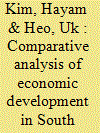

|
|
|
|
|
| Summary/Abstract |
Economic development in South Korea and Taiwan has received considerable scholarly attention, as they are two of the most successful cases since the 1960s. For all their similarities, differences also exist. Thus, we revisited economic development in South Korea and Taiwan to draw lessons for other developing countries. Our analysis indicates that no single development model will work in every country. Countries may learn from the successful cases but need to adjust the development model according to their political and economic conditions.
|
|
|
|
|
|
|
|
|
|
|
|
|
|
|
|
| 2 |
ID:
151727
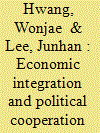

|
|
|
|
|
| Summary/Abstract |
South Korea has traditionally maintained close ties with the United States, especially for external security, while more recently it has become closer to China, mainly for economic reasons. In this article we examine whether growing economic ties between South Korea and China promote their cooperation and common policy preferences and simultaneously weaken Korea-US relations. We examine the voting congruence of South Korea and China in the United Nations General Assembly between 1991 and 2012 and find no clear evidence that economic integration promotes congruence. Rather, South Korea's policy preferences are usually determined by independent consideration of issues.
|
|
|
|
|
|
|
|
|
|
|
|
|
|
|
|
| 3 |
ID:
151725


|
|
|
|
|
| Summary/Abstract |
This article deepens our understanding of the South Korean economic miracle in three ways. First, using the most recent economic data, I demonstrate that the South Korean economy continues to impress when evaluated in comparative perspective. Second, I argue that geopolitics, such as the country's unique relationships with the United States and China, heavily shaped South Korean economic success during the Cold War years. Third, geopolitics and economic growth continue to intersect in South Korea's current strategy regarding free trade agreements.
|
|
|
|
|
|
|
|
|
|
|
|
|
|
|
|
| 4 |
ID:
151728
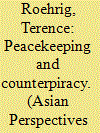

|
|
|
|
|
| Summary/Abstract |
As the international security environment grows increasingly complex, the need for multilateral solutions grows. Two such efforts are United Nations peacekeeping and counterpiracy operations off the coast of Somalia. Over the years many states have contributed police, observers, military personnel, ships, and other assets to support these multinational efforts. Since 2009 Seoul has sent a destroyer and a team of Navy SEALS to the counterpiracy operations near Somalia. In this study I contrast South Korea's contributions to UN peacekeeping and maritime security with those of Australia, China, and Japan.
|
|
|
|
|
|
|
|
|
|
|
|
|
|
|
|
| 5 |
ID:
151729
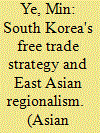

|
|
|
|
|
| Summary/Abstract |
South Korea is probably the most active state in the surging wave of East Asian regionalism. It has aggressively pursued free trade agreements (FTAs) with partners across the world in the past decade. My study focuses on the particular procedure of South Korea's FTA formation. I develop a multistage approach to examine how South Korea proposes, negotiates, signs, and ratifies FTAs with other countries. Using South Korea's data on trade with 122 trading partners from 1995 to 2012, the study offers a systematic examination of various South Korean FTA strategies at these stages. The findings demonstrate both similarities and differences between South Korea and its East Asian counterparts.
|
|
|
|
|
|
|
|
|
|
|
|
|
|
|
|
| 6 |
ID:
151723
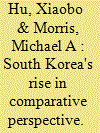

|
|
|
| 7 |
ID:
151726


|
|
|
|
|
| Summary/Abstract |
The East Asian region is in flux with the rapidly increasing rise of Chinese power and the perception of a relative decline of US influence. For US treaty allies in the region, the challenges to its regional dominance by a rising China have posed dilemmas but also opportunities. No country better exemplifies this contrast than South Korea, which as a middle power finds itself in a precarious position in the regional hierarchy. In recent years, South Korea has responded with new approaches to foreign and security strategies, which are the product of several factors: the challenges wrought by China's growth, US attempts to meet this challenge with a rebalance toward the region, and South Korea's evolving perceptions of national security. My discussion concludes that while external factors have shaped South Korea's security transformation, internal factors have been just as important drivers of South Korea's foreign policy.
|
|
|
|
|
|
|
|
|
|
|
|
|
|
|
|